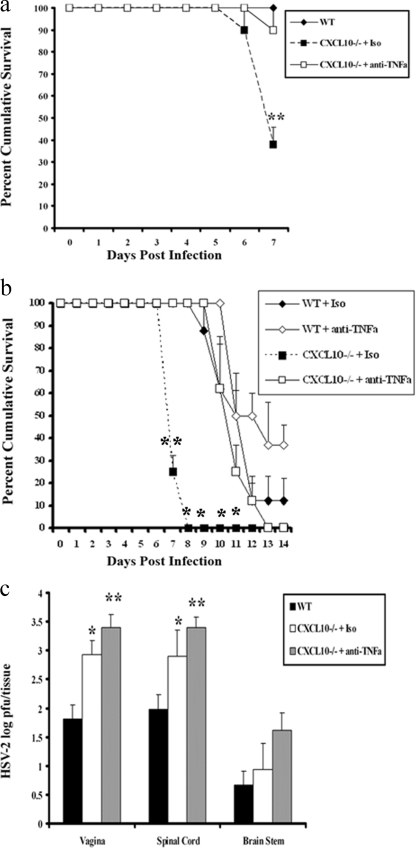FIG. 1.
Anti-TNF-α treatment offsets the elevated mortality rate of CXCL10−/− mice. (a) WT and CXCL10−/− mice (9) (n = 18 mice/group) were rendered susceptible to genital HSV-2 by using Depo-Provera (37) and infected with HSV-2 (2000 PFU/vagina). On day 5 postinfection, 100 μg of anti-mouse TNF-α or isotypic (Iso) control Ab was administered retro-orbitally into HSV-2-infected CXCL10−/− mice. The mice were monitored and recorded for survival up to day 7 postinfection. The results are shown as means ± standard errors of the means (SEM) of results from six experiments. (b) The survival study was repeated, including WT mice with anti-mouse TNF-α or isotypic control Ab treatment, and mice were monitored and recorded for survival up to day 14 postinfection. The results are shown as means ± SEM of results from three experiments (n = 8 mice/group). (c) Mice were exsanguinated, and vaginal tissue, spinal cords, and brain stems were removed, processed, and assayed for viral titer by a standard plaque assay (15). The viral titers are expressed as mean log numbers of PFU ± SEM summarized from three experiments (n = 9 mice/group). **, P values of <0.01; *, P values of <0.05 for comparison of WT to anti-TNF-α Ab-treated CXCL10−/− mice or WT to isotypic control Ab-treated CXCL10−/− mice, as determined by analysis of variance (ANOVA) and Tukey's post hoc t test.

